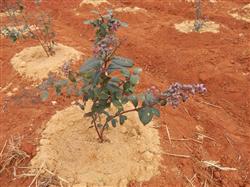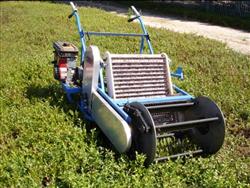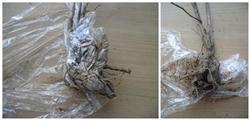What do blueberries require from soil?

What are the soil requirements of blueberries? Please introduce that orchard soil management refers to various technical measures for orchard tillage and fertilization. During the long-term growth and development of blueberry, the physical and chemical properties of garden soil deteriorated and the fertility decreased due to the interference of natural factors and human beings. In order to prevent soil deterioration, improve and fertilize the soil, and create a good environment for the root system of fruit trees, it is the basic task of orchard soil management. Blueberry has fine root system, no root hair, shallow root distribution, and requires loose, well-ventilated and acidic soil conditions. Therefore, field management is required to be more precise. The basic principles of blueberry orchard management: young orchards, small clumps, more open space in the orchard, tree plates and inter-row soil should be managed separately. The soil around the tree plate is usually ploughed, covered and sprayed with herbicide no-tillage. Soil management between orchard rows is mainly for intercrop and planting green manure. In addition, the method of growing grass between rows can also be implemented. In the adult orchard, the plant cluster has grown fully, and the root system is not satisfied with the garden. At this time, soil management should be considered uniformly in the whole garden. Clean ploughing or raw grass can be adopted. In the United States, blueberry tree plate mulching is a very common technical measure. (1) clear ploughing is a commonly used method. Due to the shallow distribution of blueberry roots, the suitable depth of clear ploughing is 5-10 cm. Clear ploughing period from early spring to summer and autumn, according to the local precipitation and weeds, can be carried out many times a year. Summer ploughing, can be appropriate deeper, near the clump slightly shallower. Shallow shovel and shallow ploughing are needed in spring and autumn. To achieve the effect of killing grass, preserving soil moisture and preventing waterlogging. As clear ploughing is easy to cause soil erosion, mountain orchards should deal with the relationship between clear ploughing and soil and water conservation. When planting blueberries in the newly reclaimed mountain woodland in the forest area, the perennial weeds are not easy to remove, and it is easy to bring out the planted blueberry seedlings in the process of weeding. Therefore, weeding needs to be careful, and it is best to prepare the land one or two years in advance to reduce the number of perennial weeds. (2) the method of growing grass is to grow grass between rows, while clear ploughing within rows or using herbicides to control weeds. Compared with the clean tillage method, the grass growing method is beneficial to the increase of yield, and has the advantages of keeping soil moisture and convenient for mechanical operation. The disadvantage is that it is not conducive to the control of blueberry infestation. The grasses used in the orchard grass method are grass grass, purple fescue grass, goose grass, ryegrass, wild oats, etc.; leguminous clover, crown flower, vetch and so on. Gramineae and legume can be mixed. (3) the technical measures of covering organic matter under blueberry clusters have been widely used in the United States. Li Yadong of Jilin Agricultural University and others have carried out research on mulching technology in some parts of China for many years, and achieved very obvious results. Mulching can improve root activity and quantity, plant growth, yield and fruit quality, and reduce soil water evaporation and irrigation times. The specific method is as follows: after blueberry planting, the soil surface of the planting row is covered with thick 5cm and wide 90cm rotten sawdust with the plant cluster as the center. The thickness increased to 12-15cm after 2-3 years. After the mature age, the thickness of the clump increased by 5-7cm every 2-3 years, and the coverage width increased to 90-120cm width. The covering period is in the dormant period of the tree. Mulching can also control the seed germination of annual weeds, but has no effect on deep-rooted perennial weeds. This technique is suitable for the cultivation of alpine blueberries and rabbit-eyed blueberries, which do not need to be buried in winter. (4) in the first 3 years after orchard intercropping, dwarf crops can be selected as intercropping crops according to the local agricultural characteristics because of the small blueberry bushes. But we should pay attention to: first, inter-crops can not affect the normal growth of blueberries, the growth range of inter-crops must be 60-90cm away from blueberry plants, with a height of not blocking blueberries; second, inter-crops should not become hosts or disseminators of blueberries susceptible to diseases and insect pests; third, do not plant green leafy vegetables (such as cabbage, etc.) in autumn to avoid damage to blueberry branches caused by big green dust. (5) Chemical weeding in orchard blueberry orchard is an important part of orchard management. the yield of weeding orchard is more than twice that of non-weeding orchard. The cost of artificial weeding is high, and soil tillage is easy to damage the roots and trees. Therefore, chemical weeding is widely used in blueberry cultivation. Especially the dwarf blueberry, after the formation of the orchard, the whole orchard can not be artificially weeded because of the rhizome running and walking, so herbicides must be used. There are many problems in the application of chemical herbicides in blueberry orchards: first, the excessive content of organic matter in the soil can passivate the herbicides; second, the time for the use of herbicides in over-moist soil is uncertain; third, when cultivated in platform fields, it is difficult to evenly control the application of herbicides in platform ditches and tables. In spite of this, the application of herbicides in blueberry orchard has achieved more successful experience. The efficacy and environmental conditions of herbicides are related to the period of use and other factors, so various types of herbicides must be tested in a small area before being used in a large area. The use of herbicides should be as uniform as possible, and manual and mechanical spraying can be used. When spraying, lower the sprinkler, spray on the ground, try to avoid spraying on the tree. So far, there is no effective herbicide that is harmless to blueberries. therefore, the effective use of herbicides should be carried out strictly in accordance with the instructions of the pharmaceutical factory, and the new herbicides should be tested before they can be used on a large scale. It is safe to use herbicides except Monocotyledons in blueberry orchards. Click to get more strawberry planting techniques click to get more fruit planting techniques
- Prev

What is the effect of mechanical harvesting of blueberries?
What is the effect of mechanical harvesting of blueberries? Please introduce that due to the lack of labor resources, mechanical harvesting has been paid more and more attention in blueberry production. The main principle of mechanical harvesting is vibrating fruit drop. A large mechanical harvester including a vibrator, a fruit receiver and a conveyor belt can harvest 0.5ha in 1 hour.
- Next

What are the characteristics of blueberry roots?
What are the characteristics of blueberry roots? Please introduce the roots of blueberries without root hairs. For this reason, the absorption capacity of blueberry roots is much smaller than that of roots with root hairs. Its absorption area is only 1 × 10 of the root system of wheat with root hair of the same size. The roots of blueberries are thin and fibrous, and the fine roots are straight before branching.
Related
- Moge, come on! The staff of the peasant association in the producing area of cantaloupe were frightened when the crowd gathered.
- Causes and Solutions of low Fruit setting rate of Apple
- Symptoms and control measures of passion fruit virus disease
- Fruit growing lesson: how do apple orchards keep high yields?
- Can you build orchards in the mountains? What are the pros and cons?
- How to manage the coloring period of Crisson grape?
- This paper introduces the processing technology of two kinds of fig products.
- How much is a month for retired teachers in rural areas by 2020?
- How can strawberry planting increase sugar content? We should pay attention to management in many aspects.
- What are the cultivation techniques on how to improve the yield of golden fruit?

